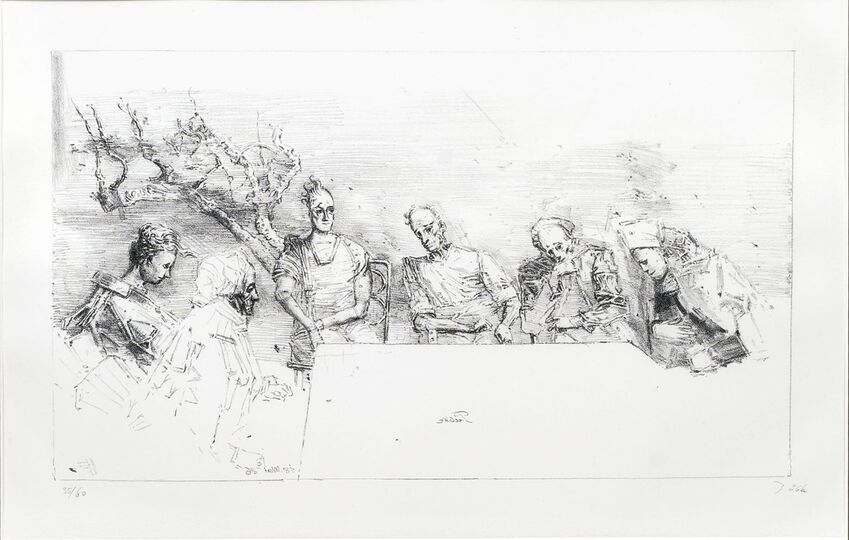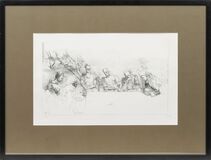Sunday Afternoon
Werner Tübke (Schönebeck 1929 - Leipzig 2004)

Lot-No. 394
Proceeds : 400 €
1986. Lithograph. 20,5 x 36 cm. Lo. ri. autographed Tübke, lo. le. num. 35/60, matted and framed under glass, uninspected out of frame. - Painter and graphic artist, one of the most important contemporary German artists. Together with Bernhard Heisig and Wolfgang Mattheuer, T. was one of the founders of the 'Leipzig School'. After an apprenticeship as a painter, he studied at the Academy of Visual Arts in Leipzig from 1948-50, then in Greifswald until 1953. Despite repeated conflicts with the GDR regime, he received state commissions such as a mural on the rectorate building of Leipzig University and the Peasant Battle Panorama in Bad Frankenhausen, and was also able to travel freely. T. soon became known outside the GDR and received awards at the Venice Biennale, among others. His compositions, which hark back to Mannerist pictorial inventions, and his many-figured depictions of history secure him a unique place in modern German art history. Mus.: Bad Frankenhausen, Hamburg (Kunsthalle), Berlin (Nat. Gall.), Dresden (Gal. Neue Meister), Frankfurt (Städel), Leipzig, St. Petersburg, Vienna, Beijing a. others.
Werner Tübke: Sunday Afternoon
Werner Tübke (Schönebeck 1929 - Leipzig 2004)
Sunday Afternoon
Lot-No. 394
Proceeds : 400 €
1986. Lithograph. 20,5 x 36 cm. Lo. ri. autographed Tübke, lo. le. num. 35/60, matted and framed under glass, uninspected out of frame. - Painter and graphic artist, one of the most important contemporary German artists. Together with Bernhard Heisig and Wolfgang Mattheuer, T. was one of the founders of the 'Leipzig School'. After an apprenticeship as a painter, he studied at the Academy of Visual Arts in Leipzig from 1948-50, then in Greifswald until 1953. Despite repeated conflicts with the GDR regime, he received state commissions such as a mural on the rectorate building of Leipzig University and the Peasant Battle Panorama in Bad Frankenhausen, and was also able to travel freely. T. soon became known outside the GDR and received awards at the Venice Biennale, among others. His compositions, which hark back to Mannerist pictorial inventions, and his many-figured depictions of history secure him a unique place in modern German art history. Mus.: Bad Frankenhausen, Hamburg (Kunsthalle), Berlin (Nat. Gall.), Dresden (Gal. Neue Meister), Frankfurt (Städel), Leipzig, St. Petersburg, Vienna, Beijing a. others.




